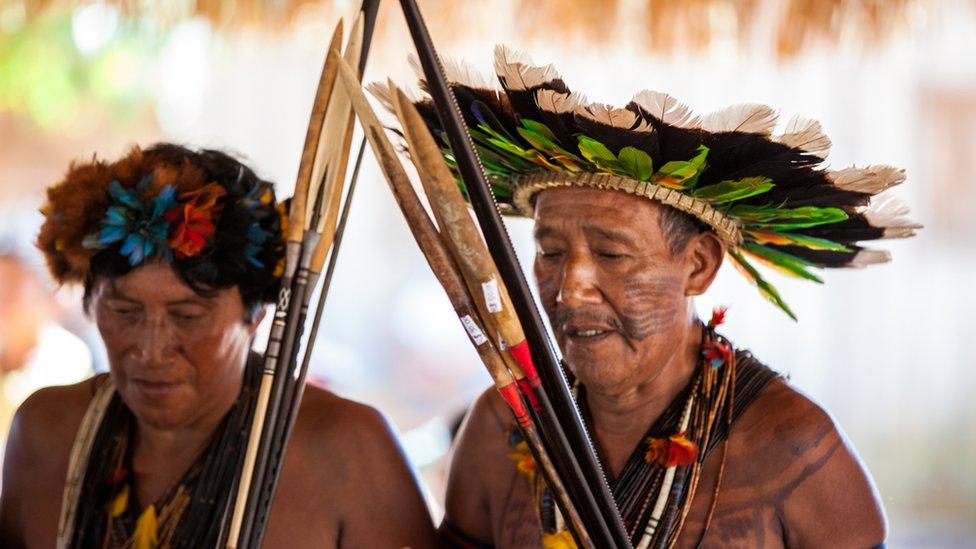The Cinta Larga and the curse of the diamonds
- Published

"Our land is our spirit," says one of the spiritual and political leaders of the Cinta Larga.
"An indigenous person without land is an indigenous person without soul," he says about the challenges facing this indigenous group in Brazil.
The group lives in the Roosevelt Indigenous Area between the states of Rondonia and Mato Grosso.
The area contains what could be the world's most abundant diamond deposit and it is these riches which are a threat to the traditional way of life of the Cinta Larga.
Under Brazilian law, no mining whatsoever should be carried out in the indigenous territory and yet illegal diamond mining has been taking place here since 1999.
An area measuring 10km by 2km (6.2 miles by 1.2 miles) in size and another adjacent area called Grota do Sossego have already been deforested for mining.
Indigenous rights activists warn that the extent of deforestation could be much greater and amount to as much as 1,000 hectares (2,470 acres).
One of the artisanal mines in the area is Lajes.
An estimated 100m reais ($31.4m; 拢25.7m) worth of diamonds is currently being extracted from it annually - all of it mined illegally. Geologists from Brazil's Geological Survey calculate that it has the potential to produce more than six times that amount.
They think the mine could yield one million carats of diamonds per year, worth more than $200m.
And Lajes is not the only site with potential riches. A mining company report suggests that the area could have as many as 14 sites of kimberlite, the rocks known to sometimes contain diamonds.
If the estimates were to be confirmed, it would make Roosevelt Indigenous Reserve the world's largest diamond deposit.
The Cinta Larga say that if it was down to them, there would be no illegal mining on their land.
"The problem is the government does not help us in any way and we are in dire need of a lot of things," a leader who preferred not to give his name explains.
"We don't have any medication or transport and there are no opportunities for us here,."
Those involved in the illegal mining have brought some services to the indigenous community to try to buy the trust of the Cinta Larga and convince them to allow the mining to go ahead on the Cinta Larga's land, he adds.
The riches of the land on which the Cinta Larga live have historically brought them misfortune. Before diamonds were discovered, rubber prospectors killed many of them for their land.
In the most infamous incident, in 1963, dynamite was thrown from a small plane on to a Cinta Larga village on the orders of a rubber plantation owner. The village was wiped out in what became known as the Massacre of the 11th Parallel.
Reginaldo Trindade, who officially defends the interests of the Cinta Larga on behalf of the attorney general's office, says that "the risk of a new genocide is the highest since then" because of the current conflict between the Cinta Larga and the illegal diamond prospectors.
The indigenous group, which once numbered more than 5,000, had dwindled to just 1,758 in the latest census taken in 2012.
The Cinta Larga say that they have to resort to diamond mining and trafficking to survive. The group receives some aid from the Brazilian state but they say it is not nearly enough. In 2014, the Cinta Larga received just under 105,000 reais ($33,000; 拢27,000), which amounted to about 58 reais ($18; 拢15) per person.
But the diamond mine has attracted outsiders to the area and with them have come other dangers. Bruno Lima e Silva, a former regional co-ordinator for Brazil's indigenous agency, Funai, says that the Cinta Larga "are the worst affected by the entry of drugs, alcohol, prostitution and violence" which the diamond mining has brought with it.
As the diamonds extracted at Roosevelt are mined illegally, getting them out of the area further attracts smugglers.
The Cinta Larga say the only solution they can see is for the ban on mining in Roosevelt to be lifted, so the stones can be extracted legally.
That way, they could exploit the riches below their land without coming into conflict with the authorities and without attracting the criminal elements currently involved in smuggling the diamonds.
"We want the mine to be legalised," says chief Marcelo Cinta Larga.
Text by Luiz Felipe Silva, photographs by Fellipe Abreu.